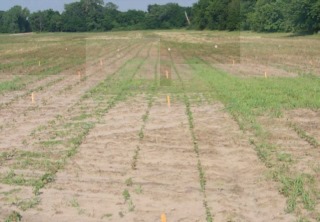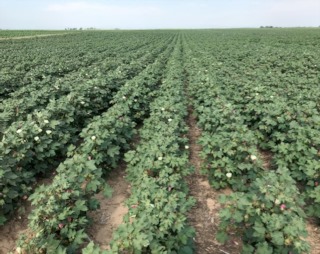By Sarah Lancaster and Lucas Haag
Early-season weed control is especially important in cotton because can be slow to canopy relative to other crops grown in Kansas, and therefore less competitive early in the growing season (Figure 1). Weeds compete with cotton for water, nutrients, and sunlight during the growing season and contribute to trash and discoloration of the lint at harvest, resulting in major dockage in quality grades and reduced value of the lint.

Figure 1. Residual herbicides applied at planting are needed to prevent early-season weed competition in cotton. Photo by Stu Duncan, K-State Research and Extension.
Tillage is often used to provide a “clean slate” for early-season weed control; however, most Kansas cotton acreage is in conservation tillage systems, so effective herbicides are needed before planting. Glyphosate is often used in burndown herbicide applications, in combination with other products. Low rates of flumioxazin (Valor, others) can be applied 14 to 30 days before planting and have some residual activity. Paraquat (Gramoxone, others) and glufosinate (Liberty, others), which only control actively growing weeds, are also effective for pre-plant burndown herbicide applications. A newer herbicide labeled for burndown applications in cotton is tiafenacil (Reviton). It is a Group 14 herbicide applied 7 to 14 days before planting at 1 to 3 fluid ounces per acre and works best when applied with glyphosate for grass control.
If dicamba-resistant cotton is planted, approved dicamba formulations (XtendiMax, Engenia, or Tavium) can be used in a burndown program with no waiting period before planting. There is a 21- to 28-day waiting period if non-dicamba-resistant cotton is planted and/or other labeled dicamba formulations are used. Similarly, the 2,4-D formulations Enlist One and Enlist Duo may be applied pre-plant with no waiting period in 2,4-D-resistant cotton, but there is a 30-day waiting period if non-2,4-D-resistant cotton and/or other labeled 2,4-D formulations are used.
Residual herbicides applied at planting are the foundation of any good weed management program. Not only are they necessary to prevent yield loss, they are also recommended to manage or delay the development of herbicide-resistant weed populations. Some effective residual herbicides for early-season use in cotton include Group 15 herbicides like acetochlor (Warrant, others), S-metolachlor (Dual, others), dimethenamid-P (Outlook), and pyroxasulfone (Zidua). These herbicides only control weeds that have not yet germinated and they require about ½ inch or more of rainfall for maximum activity. In addition to broadcast applications, pyroxasulfone (Zidua) can be impregnated on dry fertilizer and applied either preemergence or postemergence to cotton. This could be used as an opportunity to both extend residual herbicide activity as well as split applications of nitrogen to help manage plant growth in irrigated production systems. Group 5 herbicides like fluometuron (Cotoran), and prometryn (Caparol) do not have this requirement. However, these herbicides have some limitations regarding rotation restrictions to crops like corn, grain sorghum, and wheat. Similarly, pyrithiobac-sodium (Staple) will prevent rotation to grain sorghum in the following year. This restriction and the prevalence of ALS-resistant weeds have resulted in little Staple use in Kansas.
Layered residual herbicides can be especially important in cotton because it is slow to canopy (Figure 2). Group 15 herbicides can also be applied over the top of cotton if the maximum application rate for the season is not exceeded at planting. Post-emergence applications of labeled dicamba formulations (XtendiMax, Engenia) in dicamba-resistant varieties can also provide some residual control without the requirement for activating rainfall. It is important for these, and all herbicide applications to be made when cotton is at a growth stage allowed on the herbicide label.

Figure 2. Residual herbicides applied post-emergence prevent late-season weed competition in cotton. Photo by Stu Duncan, K-State Research and Extension.
For more detailed information, see the “2023 Chemical Weed Control for Field Crops, Pastures, and Noncropland” guide at https://www.bookstore.ksre.ksu.edu/pubs/CHEMWEEDGUIDE.pdf or check with your local K-State Research and Extension office for a paper copy.
Source : ksu.edu